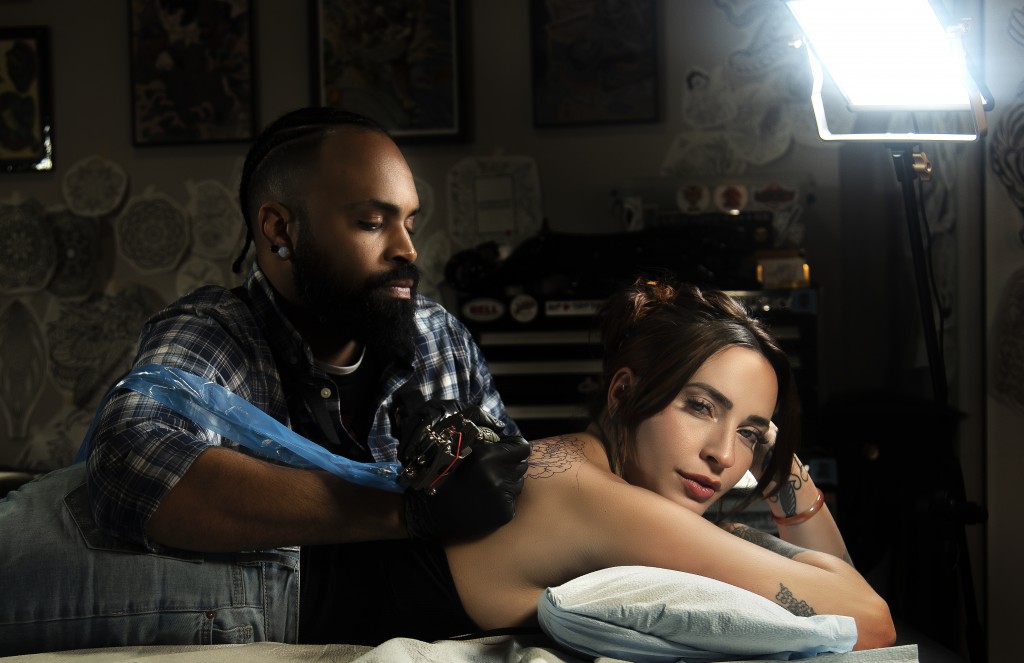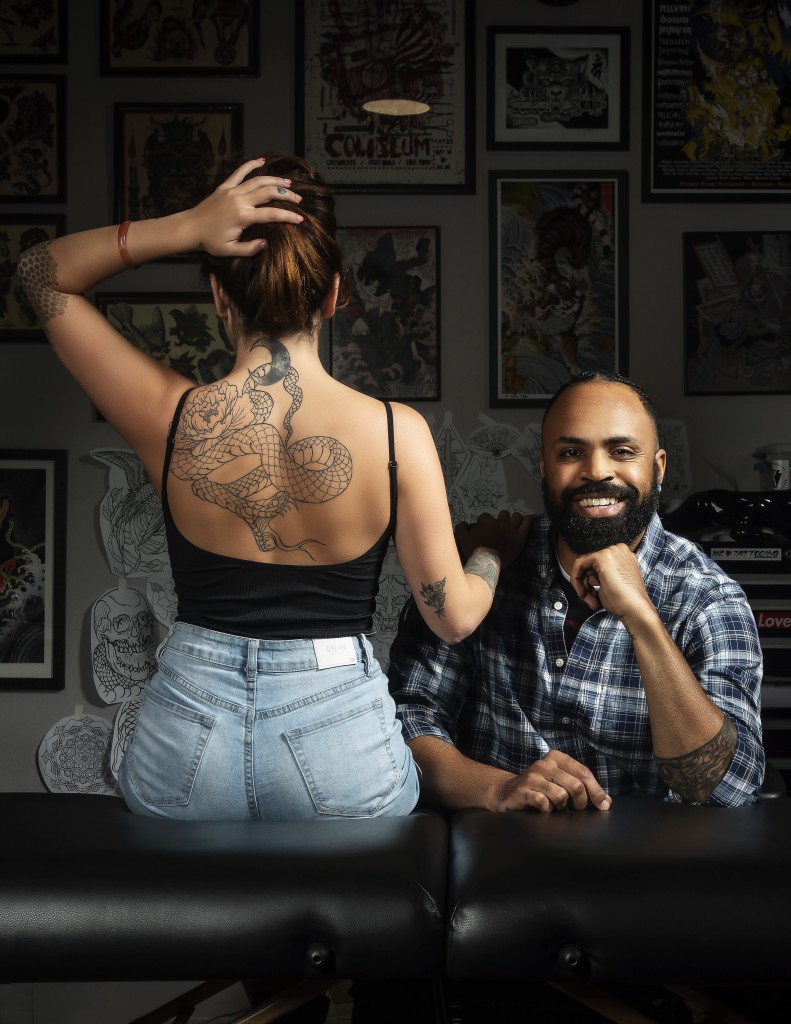The body is a temple, but for some it may look more like a gallery. Decorating the body with permanent pieces of art in the form of tattoos is a type of outward self-expression and body reclamation.
But just as beauty campaigns and brands’ social media channels are lacking in brown-girl hands, aspiring body-art collectors of color know all too well that the tattoo world has a similar problem with representation.You don’t have to scroll too far down on popular tattoo accounts to notice the dearth of brown hands, wrists, arms, thighs, necks, backs, and collarbones. While countless Instagram grids can showcase pieces as diverse as tiny-script tattoos and sizable, shaded stoic creatures, they’re overwhelmingly showcased on white and light skin. Meanwhile, limbs that would wear Fenty Pro Filt’r foundation shades in the sepia-toned 300s and 400s are few and far between.
The tattoos that people get are as nuanced as the skin they live on—but what about the people behind the needles? As tattoo artists become forces of their own (thanks to social media and celebrity clientele), there’s an obvious dearth of Black artists at the forefront. But that doesn’t mean they don’t exist.
In America, the tattooing industry has often been presented as a blue-collar old boys club. But, thankfully, the industry has undergone some serious shifts in recent years. More femmes and queer folk are visibly taking up space. Machine-free tattooing has surged in popularity once again, and tattooers with deep, nuanced relationships to their work and their clients are becoming easier to find. I spoke to Adrien Moses Clark of Love Hate Tattoo, a wonderful artist practicing at the vanguard of his industry’s sea change, to see what he had to say about his practices and making his own way in the tattoo world.
How did you get your start in the tattoo industry, and what inspired you to pursue this path?
I found myself working the counter in the same shop Shawn Conn was tattooing in. I would sketch in my downtime there, and as I did, my artwork gravitated more towards tattoo art. I was fortunate that Shawn took notice and chose to offer me an apprenticeship. His faith in me without a doubt contributed to inspiring me to continue forward.When Jet at Love Hate took me on, he helped to further my knowledge on tattooing, and seeing that improvement helped to inspire me to continue and to never truly be satisfied. I always want to improve, and I always want to be a student of this craft as a result.
Did you feel you saw yourself represented in the industry? Was there anyone you looked up to or anyone who mentored you?
I don’t know that I can say I saw myself represented in tattooing when I first started. At the same time, however, social media wasn’t the behemoth that it is now. That being the case, I didn’t know of all the other tattooers out there that may be more similar to myself in any number of ways. In my early days there were definitely artists whose work I liked when I saw it in magazines, and I would aim to have my work look similar. Ultimately, I found myself most mentored by the folks closest to me, the others in the shop along with me. The knowledge they all shared helped to keep me moving forward and to continue improving.
What advice would you give to Black aspiring artists? What advice would you give to Black individuals searching for a tattoo artist?
Ultimately, it would be the same advice I would give to anyone, and they would hopefully apply it to their own individual nature. That advice would be not to compromise themselves and who they are at their core in order to create. Being taught techniques and proper application is one thing, but respect is another thing entirely. Any teacher unwilling to respect you as a human, whether due to your ethnicity or otherwise, is likely not the one to learn from.
I suppose the first step is to make sure you like the work they produce. If you don’t like an artist’s work or style, then there likely isn’t any reason to take additional steps. From there, it comes back to respect in my eyes. If an artist isn’t willing to respect, you as a human because of anything you have no choice in, i.e., ethnicity, sex, et cetera, then don’t aim to reward them for it. I have been fortunate that if any disrespect came about because of my ethnicity that it was not overt enough to notice. That, however, doesn’t mean that it doesn’t happen in tattooing the same as everywhere else, nor that it is just limited to ethnicity. In my experience, anyone who is willing to disrespect me for any reason has been someone whose work I have, maybe not regretted getting necessarily—but—I am looking forward to covering up and moving forward keeping the lessons from it in mind. In that vein, though it can be hard with a quick first meet in many cases I say make sure you get the vibe that you will be respected no matter the things about you that life chose for you without your say.
Lastly, at the same time, respect that an artist may have their own preferences in style as well and that the work you are searching for may not be their thing. If someone’s work matches your style, and they also show respect for your person and your ideas, then they are likely a good fit.
What are your favorite types of pieces to work on?
I am way up for making mandala tattoos over most anything else. Adding other subject matter, such as other geometric work, flowers, or animals only adds to the fun I have creating. I also love working in styles rooted in Japanese traditional and American traditional tattoo work. Bold lines are my favorite, though I also enjoy the challenge of some of the finer ones as well.
What are some of the challenges you face in the industry or as an artist?
I would say one of the biggest challenges I face in tattooing is avoiding feelings of stagnation and never being satisfied with where I’m at. Always feeling like I can do better even if I love what I’ve just created. I fall right into that “own worst critic” trope when it comes to my work. In those moments, sometimes I remind myself where I started and how much I’ve progressed by looking back at work from the beginning of my career. It helps me to erase the doubts that can sometimes unrepentantly stand in my way.
What is your process for creating a tattoo for a client? For me, there is always a good part of the collaboration between the artist and the client. How do you maintain your style with a commission, and how often do you have freedom for a creation?
Once I have my client’s idea and any reference they may have sent, I will work up a draft. From there I make revisions and refine the early draft until it evolves into what I see fitting the idea best. These days I am far more insistent on working in my own style, styles I enjoy, or some hybrid of the two that allows me to create the best piece I can. I used to take on anything I felt capable of, but now I find it more important to take on ideas that allow me freedom to create something I am passionate about. I feel people get the best work in that fashion. Fortunately, I typically always have that freedom at this stage in my career.
Big thanks to Adrien Clark and Love Hate Tattoo (47 State St., Rochester) for allowing us in their space.
To book an appointment with Adrien Clark, email
am****************@gm***.com
.
Model : Rita Levy
Levy is a client of Adrien Clark’s and is getting a back piece finished.
Views: 3







